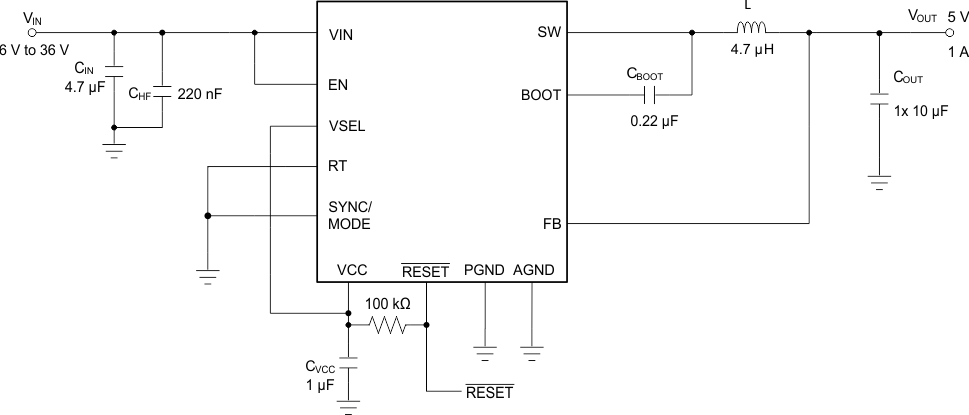JAJSMA0A July 2020 – July 2021 LM63610-Q1
PRODUCTION DATA
- 1 特長
- 2 アプリケーション
- 3 概要
- 4 Revision History
- 5 Device Comparison Table
- 6 Pin Configuration and Functions
- 7 Specifications
- 8 Detailed Description
- 9 Application and Implementation
- 10Power Supply Recommendations
- 11Layout
- 12Device and Documentation Support
- 13Mechanical, Packaging, and Orderable Information
パッケージ・オプション
メカニカル・データ(パッケージ|ピン)
サーマルパッド・メカニカル・データ
発注情報
9.2 Typical Application
Figure 9-1 shows a typical application circuit for the device. This device is designed to function over a wide range of external components and system parameters. However, the internal compensation is optimized for a certain range of external inductance and output capacitance. As a quick start guide, see for typical component values.
 Figure 9-1 Example Application Circuit
VIN = 12 V, VOUT = 5 V, IOUT = 1 A,
ƒSW = 2.1 MHz
Figure 9-1 Example Application Circuit
VIN = 12 V, VOUT = 5 V, IOUT = 1 A,
ƒSW = 2.1 MHzTable 9-1 Typical External Component Values for 1 A Output Current
| ƒSW (kHz) | VOUT | L (µH)(1) | TYPICAL(2) COUT | MINIMUM(2) COUT | VSEL | RT | CIN | CBOOT | CVCC |
|---|---|---|---|---|---|---|---|---|---|
| 400 | 3.3 | 10 | 4 × 10 µF | 2 × 10 µF | AGND | VCC | 4.7 µF + 220 nF | 220 nF | 1 µF |
| 2100 | 3.3 | 4.7 | 2 × 10 µF | 1 × 10 µF | AGND | AGND | 4.7 µF + 220 nF | 220 nF | 1 µF |
| 400 | 5 | 10 | 4 × 10 µF | 2 × 10 µF | VCC | VCC | 4.7 µF + 220 nF | 220 nF | 1 µF |
| 2100 | 5 | 4.7 | 2 × 10 µF | 1 × 10 µF | VCC | AGND | 4.7 µF + 220 nF | 220 nF | 1 µF |
(1) See the Inductor Selection section.
(2) See the Output Capacitor Selection section.